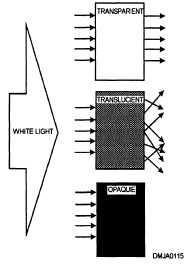Light, Continued
Absorption
Absorption occurs when light strikes a medium and the light neither reflects
from nor passes through the medium.
The surface of the medium will, to
some extent, both reflect and absorb light. How an object absorbs light
determines the color of the object. Neutral colors, such as white, black, and
various tones or values of grey absorb almost equal proportions of the colors
of light. White is highly reflective. Black, no matter how much light falls
on it, can never be recorded on film except by contrast.
Transmission
Light rays pass through some media they encounter. When objects are
clearly seen through the medium, the medium is said to be transparent.
Transparent media transmit light rays in regular or uniform patterns. When
the medium transmits light but breaks up the order of the pattern and sends
the transmitted rays to different directions, the medium is referred to as
translucent.
An opaque medium does not allow light to pass through.
Refraction is a form of transmission. Refraction is the change in direction
that occurs when light rays pass from one transparent substance into another
substance of different density.
Figure 2-5 shows the effect of different media on light rays.
Figure 2-5.—The effect of
different densities on light rays.
Continued on next page
2-7

